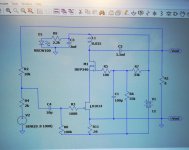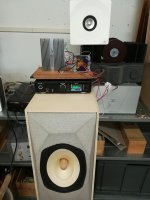lower speaker output must be taken from GND
mark PSU Neg
PSU Neg is not GND
is better open new Thread .....?Long ways from done.
sorry, my bad - you connected output properly
it's just my old eyes and brain confused with those toy power connector symbols

it's just my old eyes and brain confused with those toy power connector symbols

After having received the Lovoltechs
the Zenductor LU is up and running.
In order to shine it requires a much higher bias setting than the Zenductor.
Current operating point is 12V at 1.55 amperes. Gain 10db
The rats nest is built exactly as per below drawing.
Hope somebody will chime in soon and share his experience
Porn for Zen Mod only
the Zenductor LU is up and running.
In order to shine it requires a much higher bias setting than the Zenductor.
Current operating point is 12V at 1.55 amperes. Gain 10db
The rats nest is built exactly as per below drawing.
Hope somebody will chime in soon and share his experience
Porn for Zen Mod only
Attachments
This may muddy the waters, help illustrate a concept, or perhaps further my understanding?
On my 'normal' Pass Labs DIY projects my incoming ground coming from my receptacle is tied directly (for safety reasons) to the chassis.
The 'ground' of my bipolar supply, the negative of my single ended input, and my negative speaker output are tied together in a star and
connected to the chassis through a single (10Ohm) CL-60.
Since the Zenductor's GND has no ties to the household (even through a CL-60) supply it is less of a GND and more or a means
of connecting certain portions of the circuit together?
Please refrain from any condescension or demonstrations of hubris in your answer.
Regards,
Dan
On my 'normal' Pass Labs DIY projects my incoming ground coming from my receptacle is tied directly (for safety reasons) to the chassis.
The 'ground' of my bipolar supply, the negative of my single ended input, and my negative speaker output are tied together in a star and
connected to the chassis through a single (10Ohm) CL-60.
Since the Zenductor's GND has no ties to the household (even through a CL-60) supply it is less of a GND and more or a means
of connecting certain portions of the circuit together?
Please refrain from any condescension or demonstrations of hubris in your answer.
Regards,
Dan
what about replacing r11 with a other 35mH choke and remove r2 nfb resistor?
local degeneration (a la lufo) instead of feedback loop
local degeneration (a la lufo) instead of feedback loop
Regarding post 368
LT Spice helps a lot to get an idea of what happens when you introduce modifications to the circuit.
Without feedback gain will be very high
Changing R11 from 10k to 30k means gain from 10 to 21db
Substitution of R2 with a choke does not change the output as long as you respect the bias amperage
LT Spice helps a lot to get an idea of what happens when you introduce modifications to the circuit.
Without feedback gain will be very high
Changing R11 from 10k to 30k means gain from 10 to 21db
Substitution of R2 with a choke does not change the output as long as you respect the bias amperage
regarding no feedback ......... yeah
just put fully passive RIAA Eq in front, feed with Shure 75, full blast

just put fully passive RIAA Eq in front, feed with Shure 75, full blast

@dantwomey I was confused at first as well, as ZM says...GND is a state of mind. Remember you're still using a single supply, not bipolar.

Last edited:
R1 represents the speaker loadWhat is R1 doing is it introdusing some positive current feedback ?
Hereafter some measurements of the Zenductor Lu version.
If there is an improvement over the original circuit, there also is no free lunch. It comes at higher bias current.
The measured results are not as good as in Spice.
Further tweaking with R2 , R11, bias and maybe also other LU1014d samples may tell.
If there is an improvement over the original circuit, there also is no free lunch. It comes at higher bias current.
The measured results are not as good as in Spice.
Further tweaking with R2 , R11, bias and maybe also other LU1014d samples may tell.
Attachments
Question #1 would be how does the ZenLu sound compared to standard?
Question #2 would be how about letting ZenLu breathe more with a higher voltage supply, say 19V or even 24V?
Question #2 would be how about letting ZenLu breathe more with a higher voltage supply, say 19V or even 24V?
Re # 1
To me and a friend of mine who often drops by, mids and highs are softer, more tube like. Also resolution seems to be better. Urge and drive is still there as with the original. Selection of speakers is important. For instance the Markaudios and Diatones benefit more than the Sonido 096a.
Re # 2
Most probably the ZenLu will profit from higher voltage.
I was particularly interested to just "improve" the original, sticking to the same power requirements. We already know that this shall not be possible.
Nevertheless i shall continue. But it will not be before some longer time. (hospital and recovery...)
Would be nice if somebody would take over
PS
I wonder what Pa Nelson would have to say. Most probably he knows the answer already. He is just nice enough to let us dream and play a bit
To me and a friend of mine who often drops by, mids and highs are softer, more tube like. Also resolution seems to be better. Urge and drive is still there as with the original. Selection of speakers is important. For instance the Markaudios and Diatones benefit more than the Sonido 096a.
Re # 2
Most probably the ZenLu will profit from higher voltage.
I was particularly interested to just "improve" the original, sticking to the same power requirements. We already know that this shall not be possible.
Nevertheless i shall continue. But it will not be before some longer time. (hospital and recovery...)
Would be nice if somebody would take over
PS
I wonder what Pa Nelson would have to say. Most probably he knows the answer already. He is just nice enough to let us dream and play a bit
How critical is it that the choke is exactly 35mH? Importing iron from the US can get expensive for us europeans, perhaps this Italian choke can do the same job: https://shop.piemme-elektra.it/Categories/89/Products/7434
- Home
- Amplifiers
- Pass Labs
- Zenductor


